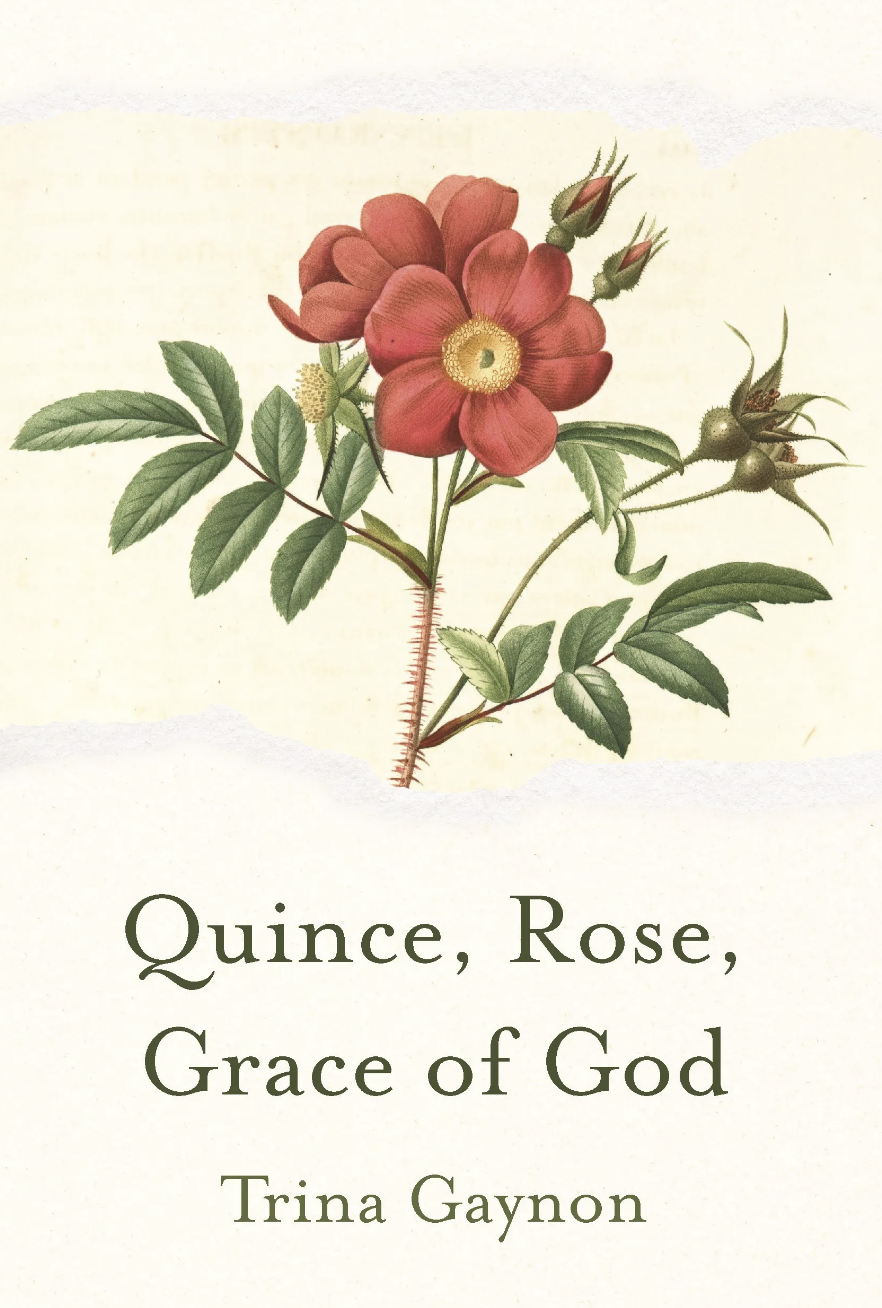
November 21, 2024
On the Edge of Memory and Place: A Conversation with Poet Trina Gaynon
Trina discusses the themes and inspirations behind her recently published poetry collection, Quince, Rose, Grace of God, exploring the intersection of poetry with ideas of place, memory, gender, and time.
by Henry Christopher
BADLANDS
Eating oranges she crossed Death Valley,
left her car and began walking along the road,
a pilgrim on the edge of the salt waste
with its ravens. The grit of dunes blew around her.
Staring into shadowed arroyos, she stood
on the rim of the Grand Canyon, snow captured
in her hair— the rest of her swaddled against the cold.
The wind bent mesquite and carved granite.
Here in Richmond where the canyon winds left her,
she closes the door of her stucco house behind her.
She walks out on a half-finished poem, photograph
albums of those trips. She’s looking for another edge.
She walks city streets under a full moon before dawn,
passing leaf-stripped trees and bakery vans. Boot heels
tap out restless prayers against concrete. Prayers rise
to vanishing stars. The horizon becomes a pink halo.
HENRY
Can you speak a bit about how you envision place operating in this collection? When you wrote the collection, did you have a specific locale or community in mind? Or, if it's more of an American survey, how do these poems mean to communicate your experiences of American society?
TRINA
The landscape at the center of the collection is Richmond, California. This Bay Area community struggled with economic losses and social changes in the 1990s. It treasured its Rosie the Riveter image from the Second World War. But due to development to the north along the freeway, downtown was dying. It was one of the few communities close to my job at Berkeley Lab where I could afford to buy a house. I wanted to establish roots there. The majority of the poems were written during the twenty years I spent in the Bay Area.
With the theme of naming all I loved, I reached back into family history. My father’s family had a multi-generational connection to Tennessee, which he broke when he joined the Air Force. By the time I got to high school he had been posted in Arizona, Okinawa, Texas, Idaho, England, and Louisiana, eventually retiring to Tennessee. My mother’s family homesteaded in Arizona then relocated to San Diego for aeronautics work during World War II. I carried all of these personal landscapes with me to Richmond.
If seen as an American survey, which seems a rather grand concept to me, these poems might communicate how varied and inclusive American society can be.
HENRY
The image of the sea seems so powerfully rooted in this collection. “The Threat of Drowning,” “Submerged,” and “Monarchs,” dwell on ocean waters to name a few. I’m guessing this comes from your time in the Bay Area, as well. How does the—literal—fluid landscape of the Pacific Ocean influence your poetic eye, and what are you hoping to communicate about it to readers—especially readers who may not have ever been to these places before?
TRINA
Just as my husband, from Chicago, orients himself by “the lake,” my directional sense relies on knowing which way is west to the Pacific. Places where the ocean touches shore become liminal spaces, where all is in flux. Though tides can be timed and set down in a table that makes them seem almost routine, those patterns can be filled with surprises.
I’m in awe of the ocean. It wasn’t until I began to arrange work to share at readings that I realized how often my sea is a menacing force, as it is in “The Threat of Drowning,” “Submerged” and “Wife of a Prison Gardener.” Such great natural powers force us to realize how fragile human life is. In each of these poems the ocean’s influence on a wife and/or mother is emphasized.
For readers who have never experienced the sea, I wish I could convey the immense size and ever-changing beauty. It fills the senses with distinctive smells (salt water), sounds (gull cries), touch (grit of sand underfoot), and tastes (salt, always salt). Sometimes a visit to the shore can fill you with a deep sense of calm.
HENRY
Going back to the topic of your theme, “naming all [you] loved,” I notice a heavy slant toward the past-tense of that theme—poems that serve as a commemoration to things, people, places, and ideas loved: “Down the Road,” for instance, which seems to be about a once-neighboring family moving to South Carolina, or “Prayers for the Barren,” which grapples with infertility. I think of the line in that poem, “I claim not to miss my lost children / but send the neighbors’ little ones, / who see and speak my empty hours / back into the cold to play.” Can you speak to the relationship in your poetry between love and longing, or presence and absence? How does poetry help you in the labor of remembering, especially when it comes to multi-generational narratives?
TRINA
I struggle with the concept that to be able to call a plant, an animal, a person, or an emotion by a generally recognized name is a way to claim it for my own. Identifying a bird as a sea gull doesn’t make the bird mine. But it does allow me to see it more distinctly, to form a more intimate relationship with the gull, to feel pleasure in watching it fly and miss its cry when I’m away from the sea— then to share those experiences. I want to know more about the world. Knowledge can become intimacy. Intimacy, love. Perhaps the longing is a feeling that I will never know enough, love well enough.
You used the term commemoration. Yes, poetry is a way of honoring its subject. As Wordsworth noted “Poetry is the spontaneous overflow of powerful feelings: it takes its origin from emotion recollected in tranquility.” I might argue with his choice of tranquility as an adjective. But ‘to recollect’ implies loss, if only in referring to the passage of time.
Remembering can be laborious, especially when memory is fragmented by frequent relocations, as it was for me as a child of a military family. Change always includes loss—of landscapes, of daily encounters with friends, of a sense of who I am or have been. On the other hand, this allows me the freedom to begin again. I like to think I live more in the moment as a result.
HENRY
How did you go about organizing the poems in your collection? So many seem to fit together, like the images of shattered glass in "Shattered" and "Federal Building Bombed." I'm especially curious about whether you wrote some poems with the intent to pair them, or if you noticed a lot of these parallels only after writing them.
TRINA
An early draft was called Rising Early. It included a core of the poems here, though several were removed, in different sections, whose thematic connections were a lot less clear. The poems in Quince, Rose, Grace of God fell into groups related to finding my place in the world as an adult. The groups included family life, love and pain, the lone writer, the longing for connection, and unexpected places a muse might turn up. I looked for a phrase to represent each group. I wove in and out of personal experience, the observational voice, and that of a persona. One of the reasons for including “Federal Building Bombed” was to provide a historical anchor, to provide a broader context for these poems.
Perhaps only “Tor House” and “Una Jeffers’ Tower” were written as a pair. Most of these poems were written as individual pieces without the concept of working on a book. Time and distance made it possible for me to see the relationships between them and bring them together. It began as a chapbook exploring the gritty nature of a changing town. I have other manuscripts in which the frame is set before I begin writing. The problem with building a collection in this way is that some items get left out. I cannot figure out how I missed “Desert Ascent,” which appeared in St. Peter’s BList: Contemporary Poems Inspired by the Saints, Mary Ann B. Miller ed. (Notre Dame, Indiana, Ave Maria Press, 2014.).
HENRY
Your intent to explore the fluid and mutable reality of a town through time—I so much admire that. It feels as ambitious as cataloging the nature of a changing life (yours, or anyone’s—how to capture the relationships between events, loves, phases of interest without an infinity of pages and time?). As you’ve mentioned, some things inevitably get left out when you’re working with so much material. But how did you sift through your drafts to decide what would go in? Did some feel absolutely clear from the start—poems you consider the thematic or imagistic centerpieces of the collection, perhaps? Which ones felt a little less clear?
TRINA
Several of the poems talk about walking through Richmond at all times of day, listening to neighborhood sounds felt important to include. Writing the poems moved me from disengaged observation to participation. This was especially true with the young people I encountered in what was a challenging place to grow up without being swept up into a gang.
After that, I felt a need to frontend poems about how I got there, which led to the selection of poems focused on family relationships.
“Invocation” was one of the last poems added to the book. Yet, I hoped its call to “hold the world in your poems/make it sacred” casts light on all the work that follows.
In retrospect it is difficult to identify those whose relationship to themes and development of images is less clear. The poems continue to rub against each other over time and new themes and images emerge. Readers bring their perspectives to bear.
HENRY
Your poetic voice moves fluidly between the feminine and the masculine with such precision. How do you see gender, bodies, and perspective operating in your collection?
TRINA
Some of this movement between feminine and masculine voices is rooted in writing short stories. I found the easiest part of that process to be writing dialogue. I always loved letting the characters talk. For me, voice is never disembodied. It arrives with a number of attributes which include gender, age, and world view. It’s important to me to explore a variety of experiences, not be limited in my writing by my own gender, age, and world view. It’s all part of surrendering to language.
HENRY
I’m always curious about audience when reading poetry. You utilize Christian imagery and Biblical themes in your poems, though you never steer too far from the narratives that are also well-known in other belief systems: “The Catch,” for instance, is a very concrete retelling of the three denials of Simon Peter as futurecasting, told from a time when “Christ has yet to ask him / to become a fisher of men.” None of the poems felt explicitly inaccessible to audiences approaching from a less Christian slant; did you envision a perfect audience member (or collective of audiences) for this collection when you began writing and compiling it? Also, how did you select which Biblical narratives were right for your themes of love, distance, and relationality?
TRINA
I’m not one to sit around imagining audiences. I write what I need to write, to help me understand where I fit in the world.
Let’s take your example: “The Catch.” The source of the poem was a photograph in a seafood restaurant. I wanted to find a way to write about that fisherman. I loved those nets, how they are of service and require service: The net suspended before it falls to the water, time suspended before it takes a dramatic turn. The story of Simon Peter fit. Futurecasting works because we know (or I provide) the end of the story while leaving him in the beauty of the immediate moment.
The Richmond years were a time when I actively explored my family’s religious tradition as Methodists. Occasional brushes against faith became a search for narratives that could provide guidance for my own growth into adulthood and community. There’s an old hymn that goes “I love to tell the stories. . . of Jesus and his love.” The stories found in the New Testament are those of people being challenged to live with a higher purpose. They’re filled with longing for communion. They’re damned good stories.
HENRY
On the topic of futurecasting, I’m curious about how you understand and write about time in Quince, Rose, Grace of God. In the title drop poem, “Spring Incantation,” you write “Seek the names of those you / do not know that you may come to love them—.” You so often seem to feel out the threads of your future in the tapestries of your past. What is this poetic connection like to you? Does it feel inevitable, or mutable, or both? How do you write into the nebulous and complicated relationships of time?
TRINA
Human beings are so permeable. Time flows in and out and around us. I don’t believe that what happens in my future is predestined. There are many directions I can move in, many possible futures. Decisions I make in this moment will stay with me, will shape my future. If I reimagine my past, that too can shape my future.
How do I write into my relationship with time? I float a little, drift a little, grab on to pieces of flotsam and jetsam to assist me. I will tell past events in present tense if the subject needs that kind of immediacy.
HENRY
Lastly, to end on an open note: what’s next for your poetry? Are you working on another collection, or focusing on individual poems or themes or ideas for now? Is there a specific topic in Quince, Rose, Grace of God you feel you’d like to explore further in the future? Or, now that it’s published, do you feel you’ve entered a (well-deserved) time of rest?
TRINA
At my age, the total time I might have to write feels limited. So times of rest are hard to imagine. My struggle is to balance the writing, editing, submitting, and publicizing this new book.
I have a manuscript that I am struggling to arrange which explores the years after I left the Bay Area to get married. I relocated to Southern California. The work focuses more on the roles of householder and wife. After a brief stint in the San Fernando Valley, my husband and I moved to Huntington Beach when his job changed. So the ocean maintains a presence in this manuscript. The poems are more often in the first person, with fewer persona pieces. It includes more prose poems. Seeing Eye has limped through many versions, but may be close to completion.
At the time, I was exploring the California in Josephine Miles’ work. She was the first woman tenured at the English Department at the University of California, Berkeley. So while I first became aware of her work while in northern California, I wasn’t ready for all I could learn from it until later. Increasingly, I see my work as responses to the poets who have meant so much to me, including Jane Kenyon, Robinson Jeffers, Jane Hirschfeld, Josephine Miles, and Jean Valentine to name the most influential.
The poems being written now often leave behind personal, autobiographical territory, while I explore various mythological traditions with a Portland-based Mythology Salon that meets weekly on Zoom.
TRINA GAYNON spent forty years in California, where she claimed her poetic voice. She later moved to a suburb dropped on top of a marsh near Portland, Oregon, which she shares with her husband, a wealth of birds, an occasional snake, and a growing population of beavers. She leads a group of poetry readers at the Senior Studies Institute. Her work appears in Fire and Rain: Ecopoetry of California, other anthologies, and numerous journals. Her chapbook, An Alphabet of Romance, is available from Finishing Line Press.
HENRY CHRISTOPHER (he/they) is a lifelong artist, author and educator. He provides marketing and social media oversight to Fernwood Press, and editorial feedback for CRAFT Literary. In his spare time, he writes, collages, and freely distributes zines in the Seattle area, and volunteers at an educator-oriented secondhand art supply store.




